Pepsi Management: Corporate Strategy and SWOT Analysis - A Report
VerifiedAdded on 2023/04/21
|10
|2493
|167
Report
AI Summary
This report provides an overview of Pepsi's management strategies, customer base, mission, core values, vision, and SWOT analysis. It highlights Pepsi's market penetration, product development, and market development strategies at the corporate level, as well as its low-cost differentiation strategy at the business level. The SWOT analysis identifies Pepsi's strengths, weaknesses, opportunities, and threats, including brand equity, competition, and health concerns. The report concludes that Pepsi's business and corporate-level strategies are effective in managing its global operations, and customer loyalty provides significant opportunities for the company's continued growth. Desklib offers a platform for students to access this assignment and many other solved assignments.
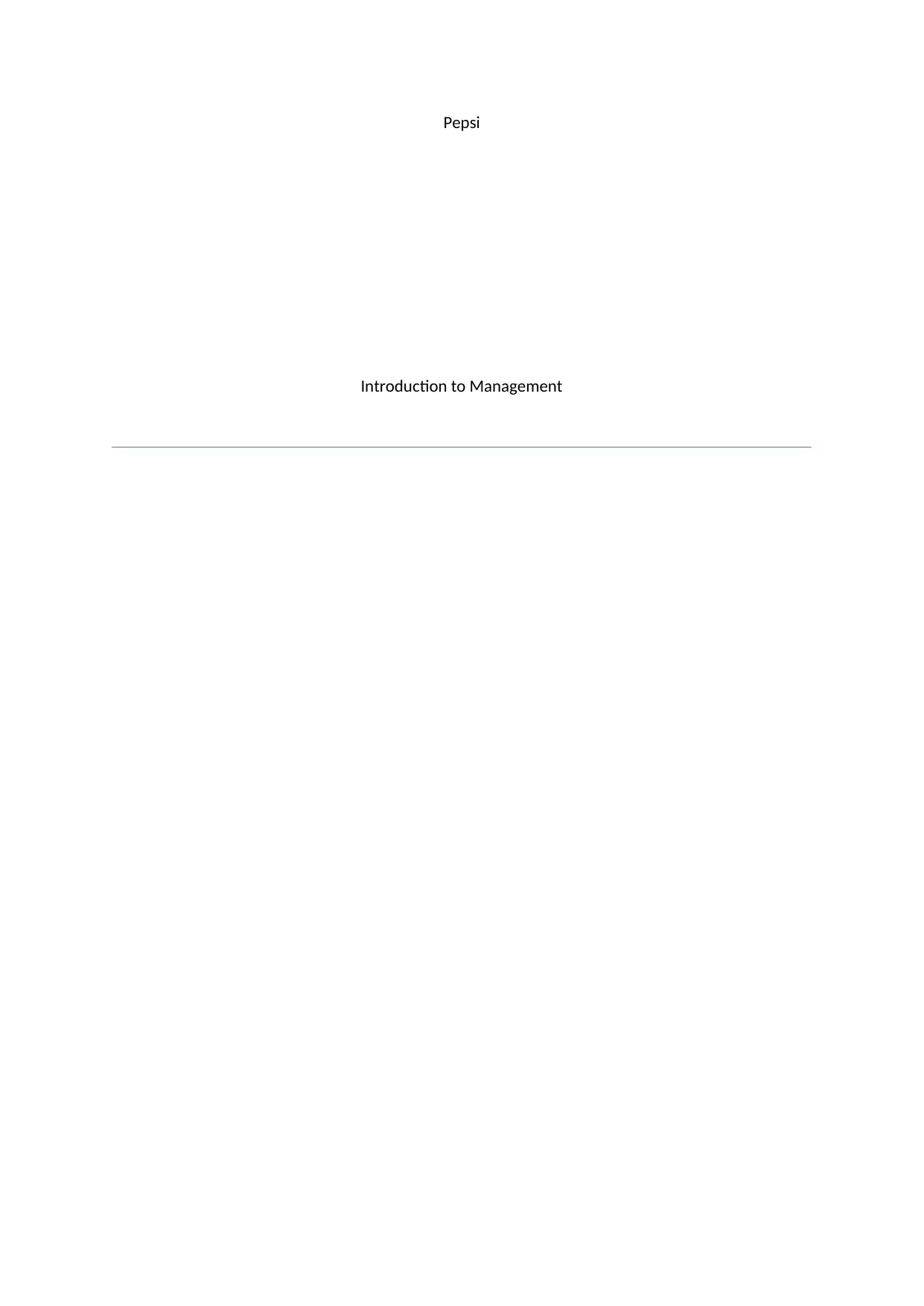
Pepsi
Introduction to Management
Introduction to Management
Paraphrase This Document
Need a fresh take? Get an instant paraphrase of this document with our AI Paraphraser
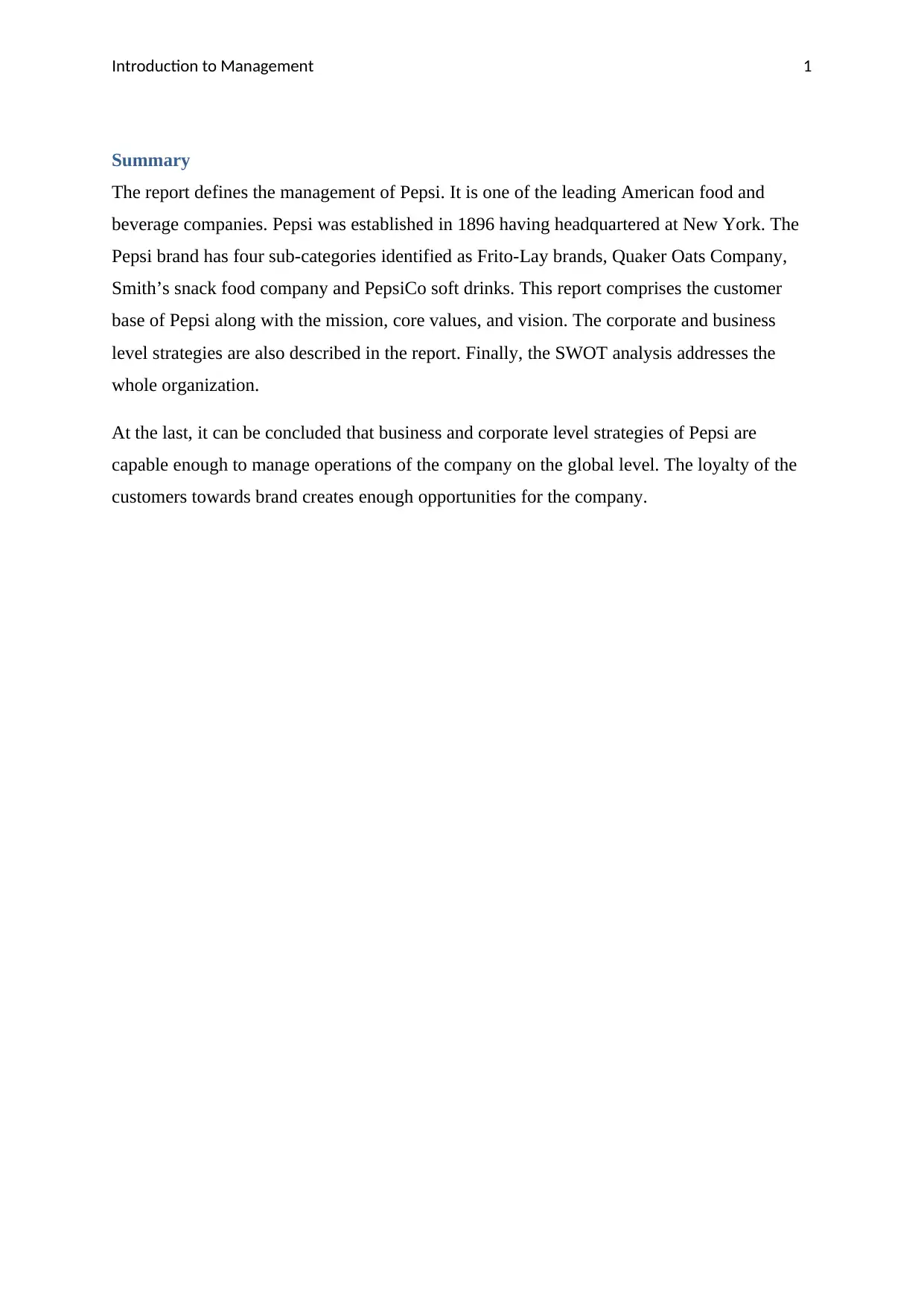
Introduction to Management 1
Summary
The report defines the management of Pepsi. It is one of the leading American food and
beverage companies. Pepsi was established in 1896 having headquartered at New York. The
Pepsi brand has four sub-categories identified as Frito-Lay brands, Quaker Oats Company,
Smith’s snack food company and PepsiCo soft drinks. This report comprises the customer
base of Pepsi along with the mission, core values, and vision. The corporate and business
level strategies are also described in the report. Finally, the SWOT analysis addresses the
whole organization.
At the last, it can be concluded that business and corporate level strategies of Pepsi are
capable enough to manage operations of the company on the global level. The loyalty of the
customers towards brand creates enough opportunities for the company.
Summary
The report defines the management of Pepsi. It is one of the leading American food and
beverage companies. Pepsi was established in 1896 having headquartered at New York. The
Pepsi brand has four sub-categories identified as Frito-Lay brands, Quaker Oats Company,
Smith’s snack food company and PepsiCo soft drinks. This report comprises the customer
base of Pepsi along with the mission, core values, and vision. The corporate and business
level strategies are also described in the report. Finally, the SWOT analysis addresses the
whole organization.
At the last, it can be concluded that business and corporate level strategies of Pepsi are
capable enough to manage operations of the company on the global level. The loyalty of the
customers towards brand creates enough opportunities for the company.
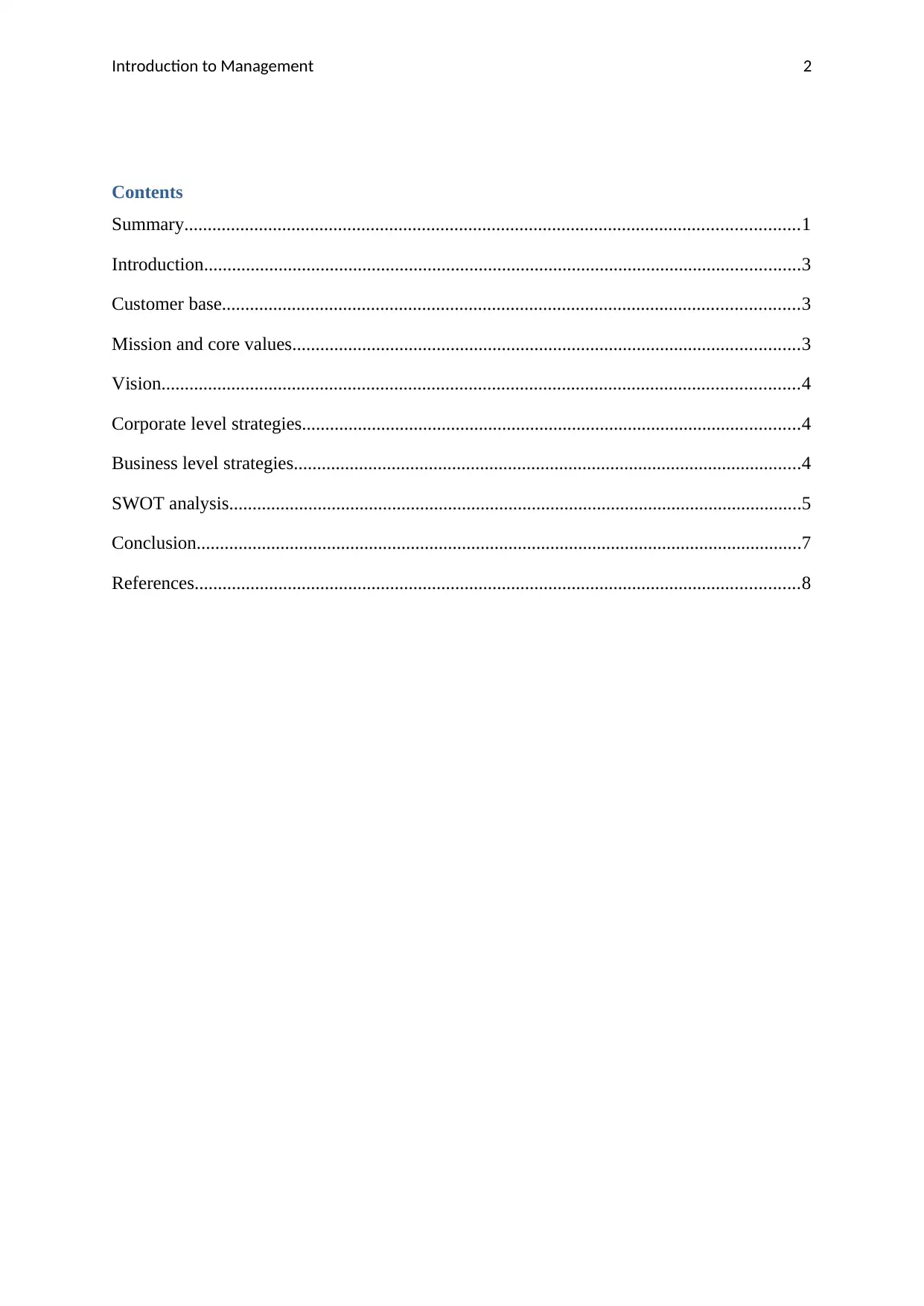
Introduction to Management 2
Contents
Summary....................................................................................................................................1
Introduction................................................................................................................................3
Customer base............................................................................................................................3
Mission and core values.............................................................................................................3
Vision.........................................................................................................................................4
Corporate level strategies...........................................................................................................4
Business level strategies.............................................................................................................4
SWOT analysis...........................................................................................................................5
Conclusion..................................................................................................................................7
References..................................................................................................................................8
Contents
Summary....................................................................................................................................1
Introduction................................................................................................................................3
Customer base............................................................................................................................3
Mission and core values.............................................................................................................3
Vision.........................................................................................................................................4
Corporate level strategies...........................................................................................................4
Business level strategies.............................................................................................................4
SWOT analysis...........................................................................................................................5
Conclusion..................................................................................................................................7
References..................................................................................................................................8
⊘ This is a preview!⊘
Do you want full access?
Subscribe today to unlock all pages.

Trusted by 1+ million students worldwide
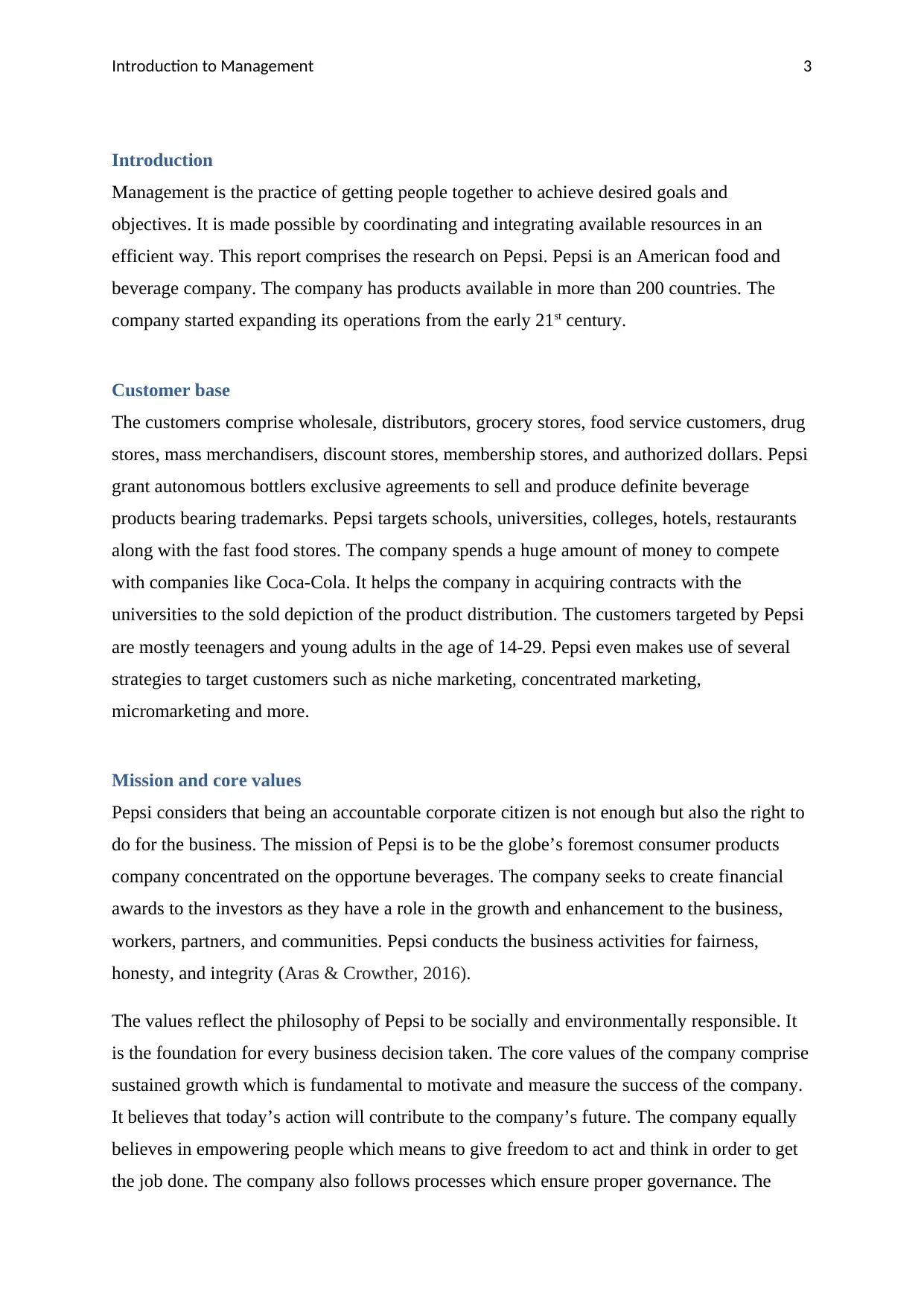
Introduction to Management 3
Introduction
Management is the practice of getting people together to achieve desired goals and
objectives. It is made possible by coordinating and integrating available resources in an
efficient way. This report comprises the research on Pepsi. Pepsi is an American food and
beverage company. The company has products available in more than 200 countries. The
company started expanding its operations from the early 21st century.
Customer base
The customers comprise wholesale, distributors, grocery stores, food service customers, drug
stores, mass merchandisers, discount stores, membership stores, and authorized dollars. Pepsi
grant autonomous bottlers exclusive agreements to sell and produce definite beverage
products bearing trademarks. Pepsi targets schools, universities, colleges, hotels, restaurants
along with the fast food stores. The company spends a huge amount of money to compete
with companies like Coca-Cola. It helps the company in acquiring contracts with the
universities to the sold depiction of the product distribution. The customers targeted by Pepsi
are mostly teenagers and young adults in the age of 14-29. Pepsi even makes use of several
strategies to target customers such as niche marketing, concentrated marketing,
micromarketing and more.
Mission and core values
Pepsi considers that being an accountable corporate citizen is not enough but also the right to
do for the business. The mission of Pepsi is to be the globe’s foremost consumer products
company concentrated on the opportune beverages. The company seeks to create financial
awards to the investors as they have a role in the growth and enhancement to the business,
workers, partners, and communities. Pepsi conducts the business activities for fairness,
honesty, and integrity (Aras & Crowther, 2016).
The values reflect the philosophy of Pepsi to be socially and environmentally responsible. It
is the foundation for every business decision taken. The core values of the company comprise
sustained growth which is fundamental to motivate and measure the success of the company.
It believes that today’s action will contribute to the company’s future. The company equally
believes in empowering people which means to give freedom to act and think in order to get
the job done. The company also follows processes which ensure proper governance. The
Introduction
Management is the practice of getting people together to achieve desired goals and
objectives. It is made possible by coordinating and integrating available resources in an
efficient way. This report comprises the research on Pepsi. Pepsi is an American food and
beverage company. The company has products available in more than 200 countries. The
company started expanding its operations from the early 21st century.
Customer base
The customers comprise wholesale, distributors, grocery stores, food service customers, drug
stores, mass merchandisers, discount stores, membership stores, and authorized dollars. Pepsi
grant autonomous bottlers exclusive agreements to sell and produce definite beverage
products bearing trademarks. Pepsi targets schools, universities, colleges, hotels, restaurants
along with the fast food stores. The company spends a huge amount of money to compete
with companies like Coca-Cola. It helps the company in acquiring contracts with the
universities to the sold depiction of the product distribution. The customers targeted by Pepsi
are mostly teenagers and young adults in the age of 14-29. Pepsi even makes use of several
strategies to target customers such as niche marketing, concentrated marketing,
micromarketing and more.
Mission and core values
Pepsi considers that being an accountable corporate citizen is not enough but also the right to
do for the business. The mission of Pepsi is to be the globe’s foremost consumer products
company concentrated on the opportune beverages. The company seeks to create financial
awards to the investors as they have a role in the growth and enhancement to the business,
workers, partners, and communities. Pepsi conducts the business activities for fairness,
honesty, and integrity (Aras & Crowther, 2016).
The values reflect the philosophy of Pepsi to be socially and environmentally responsible. It
is the foundation for every business decision taken. The core values of the company comprise
sustained growth which is fundamental to motivate and measure the success of the company.
It believes that today’s action will contribute to the company’s future. The company equally
believes in empowering people which means to give freedom to act and think in order to get
the job done. The company also follows processes which ensure proper governance. The
Paraphrase This Document
Need a fresh take? Get an instant paraphrase of this document with our AI Paraphraser
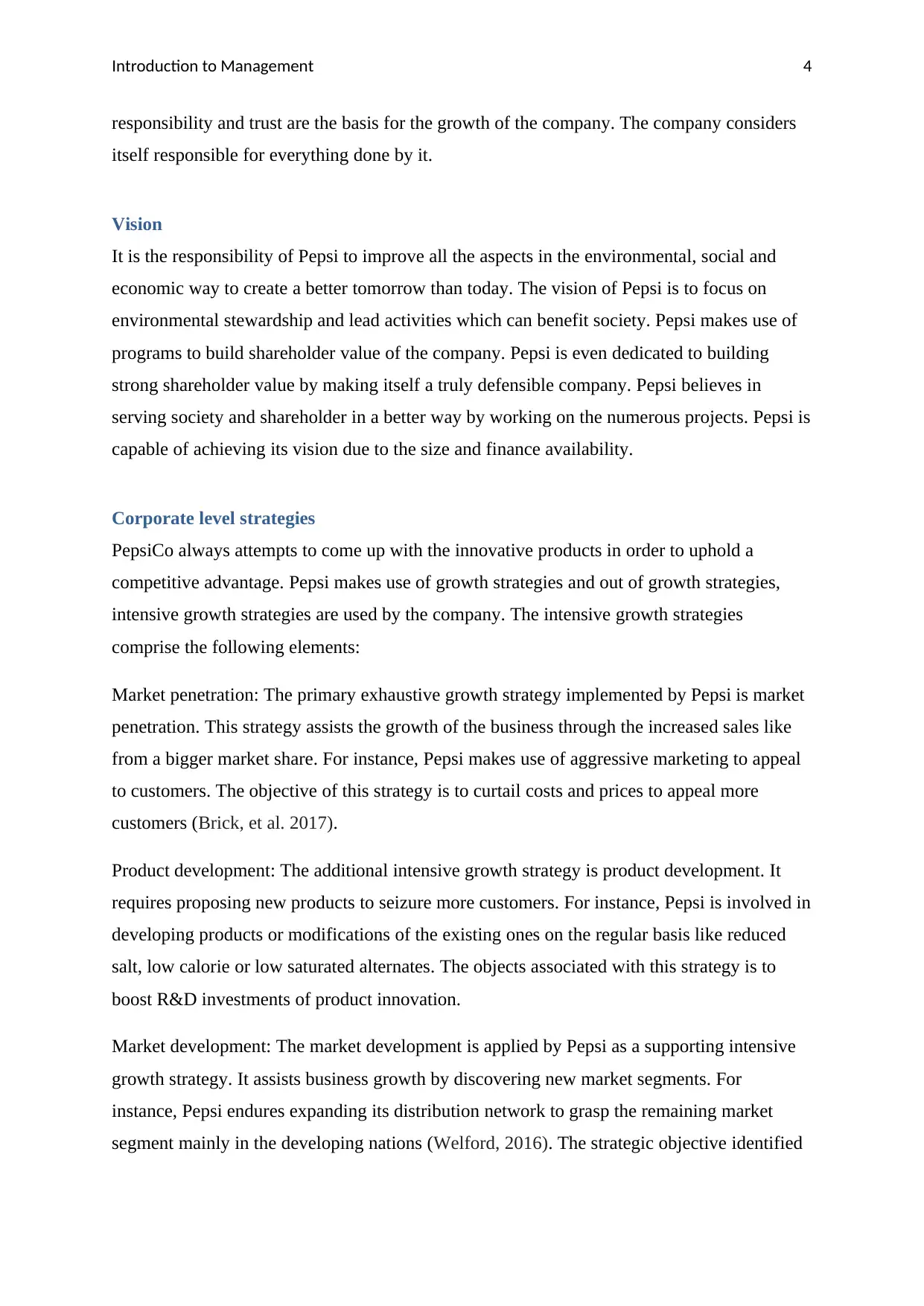
Introduction to Management 4
responsibility and trust are the basis for the growth of the company. The company considers
itself responsible for everything done by it.
Vision
It is the responsibility of Pepsi to improve all the aspects in the environmental, social and
economic way to create a better tomorrow than today. The vision of Pepsi is to focus on
environmental stewardship and lead activities which can benefit society. Pepsi makes use of
programs to build shareholder value of the company. Pepsi is even dedicated to building
strong shareholder value by making itself a truly defensible company. Pepsi believes in
serving society and shareholder in a better way by working on the numerous projects. Pepsi is
capable of achieving its vision due to the size and finance availability.
Corporate level strategies
PepsiCo always attempts to come up with the innovative products in order to uphold a
competitive advantage. Pepsi makes use of growth strategies and out of growth strategies,
intensive growth strategies are used by the company. The intensive growth strategies
comprise the following elements:
Market penetration: The primary exhaustive growth strategy implemented by Pepsi is market
penetration. This strategy assists the growth of the business through the increased sales like
from a bigger market share. For instance, Pepsi makes use of aggressive marketing to appeal
to customers. The objective of this strategy is to curtail costs and prices to appeal more
customers (Brick, et al. 2017).
Product development: The additional intensive growth strategy is product development. It
requires proposing new products to seizure more customers. For instance, Pepsi is involved in
developing products or modifications of the existing ones on the regular basis like reduced
salt, low calorie or low saturated alternates. The objects associated with this strategy is to
boost R&D investments of product innovation.
Market development: The market development is applied by Pepsi as a supporting intensive
growth strategy. It assists business growth by discovering new market segments. For
instance, Pepsi endures expanding its distribution network to grasp the remaining market
segment mainly in the developing nations (Welford, 2016). The strategic objective identified
responsibility and trust are the basis for the growth of the company. The company considers
itself responsible for everything done by it.
Vision
It is the responsibility of Pepsi to improve all the aspects in the environmental, social and
economic way to create a better tomorrow than today. The vision of Pepsi is to focus on
environmental stewardship and lead activities which can benefit society. Pepsi makes use of
programs to build shareholder value of the company. Pepsi is even dedicated to building
strong shareholder value by making itself a truly defensible company. Pepsi believes in
serving society and shareholder in a better way by working on the numerous projects. Pepsi is
capable of achieving its vision due to the size and finance availability.
Corporate level strategies
PepsiCo always attempts to come up with the innovative products in order to uphold a
competitive advantage. Pepsi makes use of growth strategies and out of growth strategies,
intensive growth strategies are used by the company. The intensive growth strategies
comprise the following elements:
Market penetration: The primary exhaustive growth strategy implemented by Pepsi is market
penetration. This strategy assists the growth of the business through the increased sales like
from a bigger market share. For instance, Pepsi makes use of aggressive marketing to appeal
to customers. The objective of this strategy is to curtail costs and prices to appeal more
customers (Brick, et al. 2017).
Product development: The additional intensive growth strategy is product development. It
requires proposing new products to seizure more customers. For instance, Pepsi is involved in
developing products or modifications of the existing ones on the regular basis like reduced
salt, low calorie or low saturated alternates. The objects associated with this strategy is to
boost R&D investments of product innovation.
Market development: The market development is applied by Pepsi as a supporting intensive
growth strategy. It assists business growth by discovering new market segments. For
instance, Pepsi endures expanding its distribution network to grasp the remaining market
segment mainly in the developing nations (Welford, 2016). The strategic objective identified
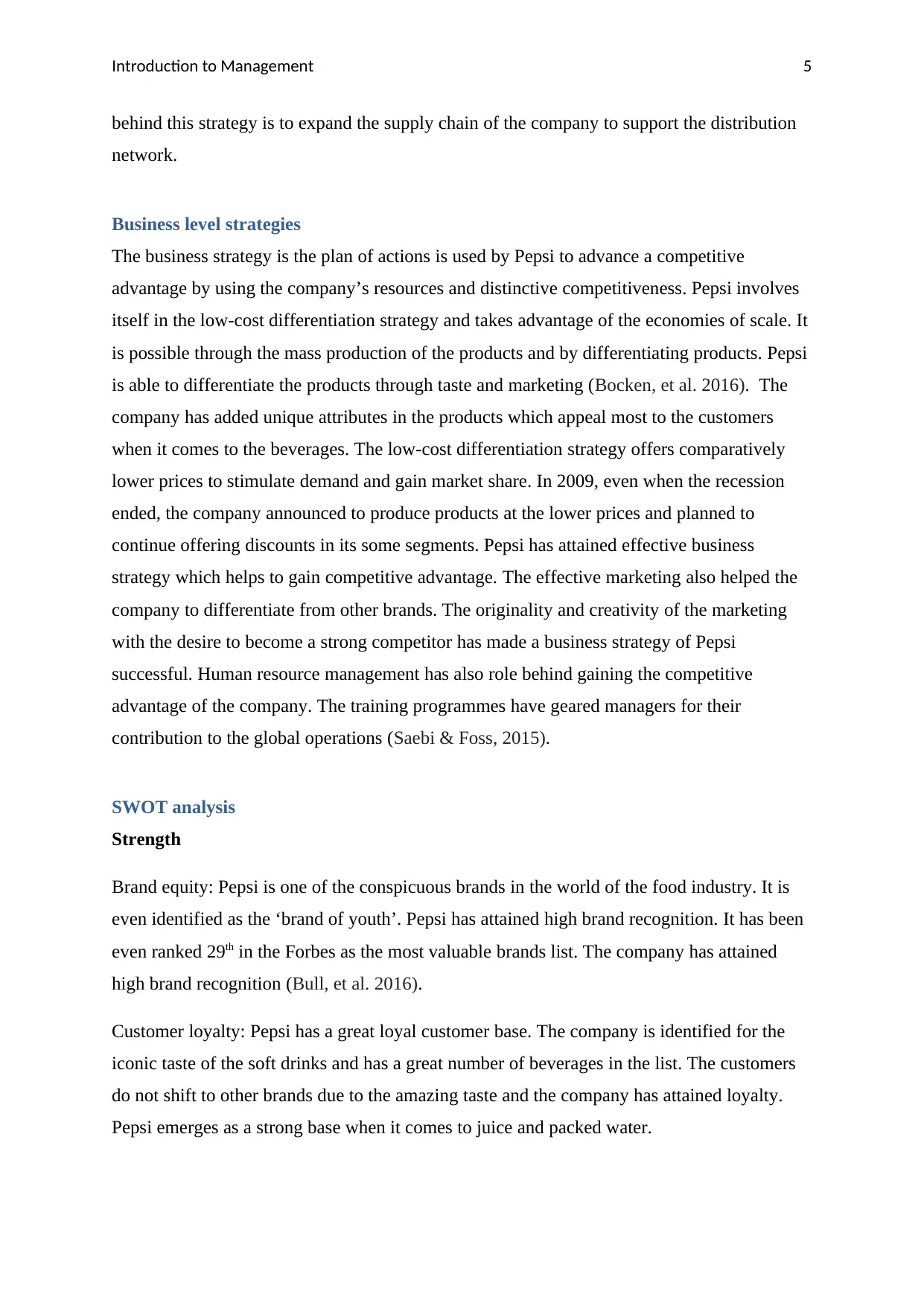
Introduction to Management 5
behind this strategy is to expand the supply chain of the company to support the distribution
network.
Business level strategies
The business strategy is the plan of actions is used by Pepsi to advance a competitive
advantage by using the company’s resources and distinctive competitiveness. Pepsi involves
itself in the low-cost differentiation strategy and takes advantage of the economies of scale. It
is possible through the mass production of the products and by differentiating products. Pepsi
is able to differentiate the products through taste and marketing (Bocken, et al. 2016). The
company has added unique attributes in the products which appeal most to the customers
when it comes to the beverages. The low-cost differentiation strategy offers comparatively
lower prices to stimulate demand and gain market share. In 2009, even when the recession
ended, the company announced to produce products at the lower prices and planned to
continue offering discounts in its some segments. Pepsi has attained effective business
strategy which helps to gain competitive advantage. The effective marketing also helped the
company to differentiate from other brands. The originality and creativity of the marketing
with the desire to become a strong competitor has made a business strategy of Pepsi
successful. Human resource management has also role behind gaining the competitive
advantage of the company. The training programmes have geared managers for their
contribution to the global operations (Saebi & Foss, 2015).
SWOT analysis
Strength
Brand equity: Pepsi is one of the conspicuous brands in the world of the food industry. It is
even identified as the ‘brand of youth’. Pepsi has attained high brand recognition. It has been
even ranked 29th in the Forbes as the most valuable brands list. The company has attained
high brand recognition (Bull, et al. 2016).
Customer loyalty: Pepsi has a great loyal customer base. The company is identified for the
iconic taste of the soft drinks and has a great number of beverages in the list. The customers
do not shift to other brands due to the amazing taste and the company has attained loyalty.
Pepsi emerges as a strong base when it comes to juice and packed water.
behind this strategy is to expand the supply chain of the company to support the distribution
network.
Business level strategies
The business strategy is the plan of actions is used by Pepsi to advance a competitive
advantage by using the company’s resources and distinctive competitiveness. Pepsi involves
itself in the low-cost differentiation strategy and takes advantage of the economies of scale. It
is possible through the mass production of the products and by differentiating products. Pepsi
is able to differentiate the products through taste and marketing (Bocken, et al. 2016). The
company has added unique attributes in the products which appeal most to the customers
when it comes to the beverages. The low-cost differentiation strategy offers comparatively
lower prices to stimulate demand and gain market share. In 2009, even when the recession
ended, the company announced to produce products at the lower prices and planned to
continue offering discounts in its some segments. Pepsi has attained effective business
strategy which helps to gain competitive advantage. The effective marketing also helped the
company to differentiate from other brands. The originality and creativity of the marketing
with the desire to become a strong competitor has made a business strategy of Pepsi
successful. Human resource management has also role behind gaining the competitive
advantage of the company. The training programmes have geared managers for their
contribution to the global operations (Saebi & Foss, 2015).
SWOT analysis
Strength
Brand equity: Pepsi is one of the conspicuous brands in the world of the food industry. It is
even identified as the ‘brand of youth’. Pepsi has attained high brand recognition. It has been
even ranked 29th in the Forbes as the most valuable brands list. The company has attained
high brand recognition (Bull, et al. 2016).
Customer loyalty: Pepsi has a great loyal customer base. The company is identified for the
iconic taste of the soft drinks and has a great number of beverages in the list. The customers
do not shift to other brands due to the amazing taste and the company has attained loyalty.
Pepsi emerges as a strong base when it comes to juice and packed water.
⊘ This is a preview!⊘
Do you want full access?
Subscribe today to unlock all pages.

Trusted by 1+ million students worldwide
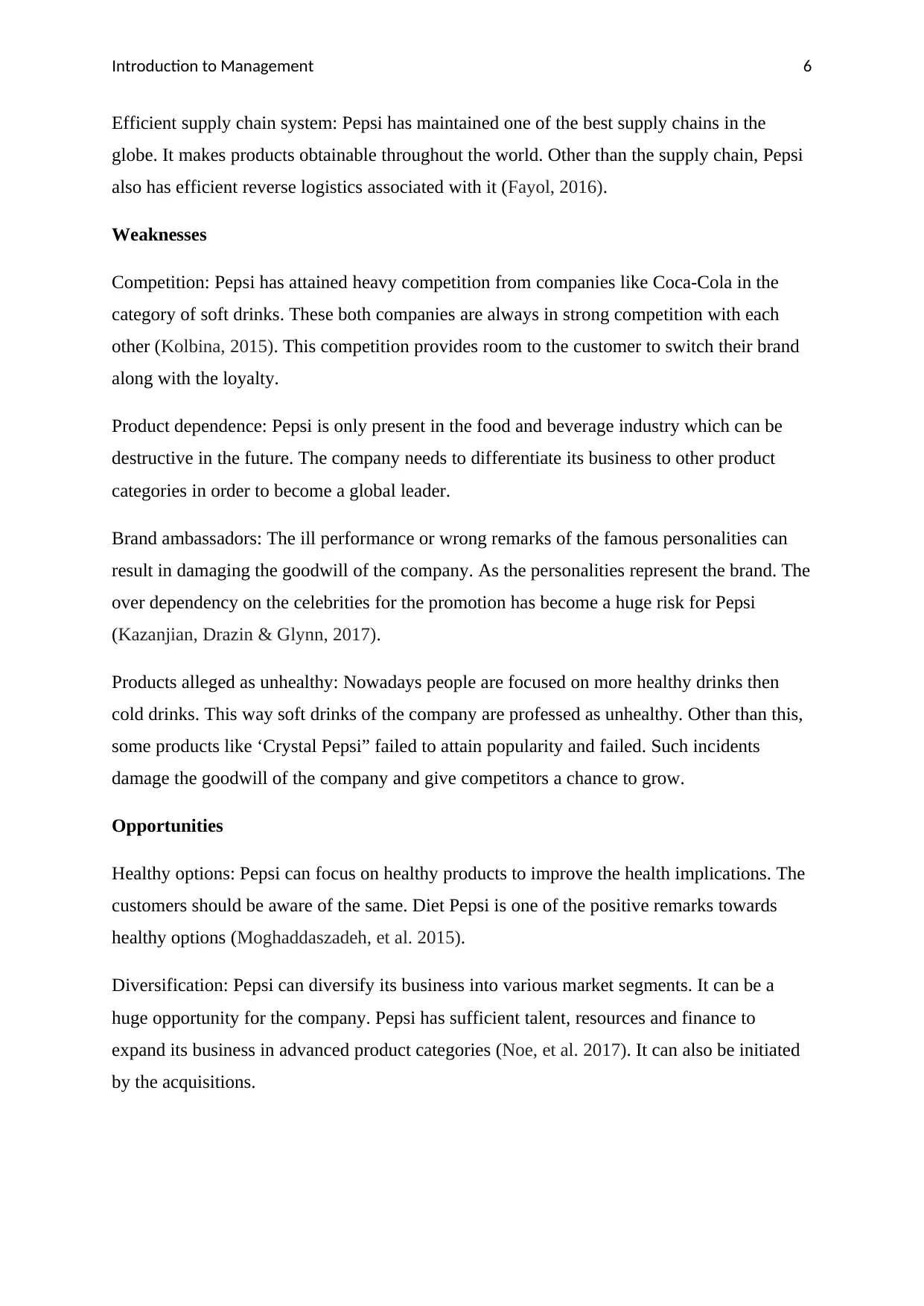
Introduction to Management 6
Efficient supply chain system: Pepsi has maintained one of the best supply chains in the
globe. It makes products obtainable throughout the world. Other than the supply chain, Pepsi
also has efficient reverse logistics associated with it (Fayol, 2016).
Weaknesses
Competition: Pepsi has attained heavy competition from companies like Coca-Cola in the
category of soft drinks. These both companies are always in strong competition with each
other (Kolbina, 2015). This competition provides room to the customer to switch their brand
along with the loyalty.
Product dependence: Pepsi is only present in the food and beverage industry which can be
destructive in the future. The company needs to differentiate its business to other product
categories in order to become a global leader.
Brand ambassadors: The ill performance or wrong remarks of the famous personalities can
result in damaging the goodwill of the company. As the personalities represent the brand. The
over dependency on the celebrities for the promotion has become a huge risk for Pepsi
(Kazanjian, Drazin & Glynn, 2017).
Products alleged as unhealthy: Nowadays people are focused on more healthy drinks then
cold drinks. This way soft drinks of the company are professed as unhealthy. Other than this,
some products like ‘Crystal Pepsi” failed to attain popularity and failed. Such incidents
damage the goodwill of the company and give competitors a chance to grow.
Opportunities
Healthy options: Pepsi can focus on healthy products to improve the health implications. The
customers should be aware of the same. Diet Pepsi is one of the positive remarks towards
healthy options (Moghaddaszadeh, et al. 2015).
Diversification: Pepsi can diversify its business into various market segments. It can be a
huge opportunity for the company. Pepsi has sufficient talent, resources and finance to
expand its business in advanced product categories (Noe, et al. 2017). It can also be initiated
by the acquisitions.
Efficient supply chain system: Pepsi has maintained one of the best supply chains in the
globe. It makes products obtainable throughout the world. Other than the supply chain, Pepsi
also has efficient reverse logistics associated with it (Fayol, 2016).
Weaknesses
Competition: Pepsi has attained heavy competition from companies like Coca-Cola in the
category of soft drinks. These both companies are always in strong competition with each
other (Kolbina, 2015). This competition provides room to the customer to switch their brand
along with the loyalty.
Product dependence: Pepsi is only present in the food and beverage industry which can be
destructive in the future. The company needs to differentiate its business to other product
categories in order to become a global leader.
Brand ambassadors: The ill performance or wrong remarks of the famous personalities can
result in damaging the goodwill of the company. As the personalities represent the brand. The
over dependency on the celebrities for the promotion has become a huge risk for Pepsi
(Kazanjian, Drazin & Glynn, 2017).
Products alleged as unhealthy: Nowadays people are focused on more healthy drinks then
cold drinks. This way soft drinks of the company are professed as unhealthy. Other than this,
some products like ‘Crystal Pepsi” failed to attain popularity and failed. Such incidents
damage the goodwill of the company and give competitors a chance to grow.
Opportunities
Healthy options: Pepsi can focus on healthy products to improve the health implications. The
customers should be aware of the same. Diet Pepsi is one of the positive remarks towards
healthy options (Moghaddaszadeh, et al. 2015).
Diversification: Pepsi can diversify its business into various market segments. It can be a
huge opportunity for the company. Pepsi has sufficient talent, resources and finance to
expand its business in advanced product categories (Noe, et al. 2017). It can also be initiated
by the acquisitions.
Paraphrase This Document
Need a fresh take? Get an instant paraphrase of this document with our AI Paraphraser
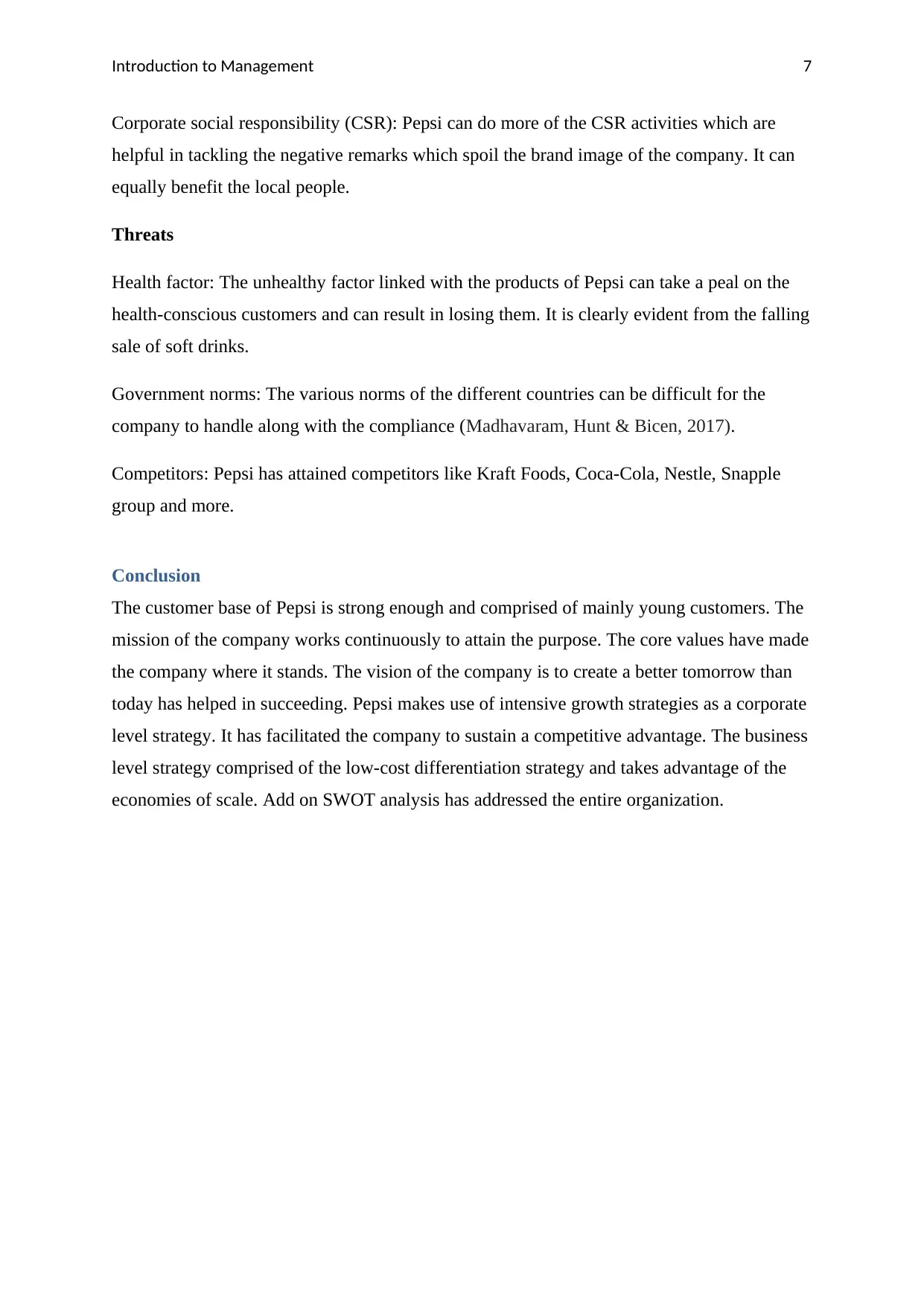
Introduction to Management 7
Corporate social responsibility (CSR): Pepsi can do more of the CSR activities which are
helpful in tackling the negative remarks which spoil the brand image of the company. It can
equally benefit the local people.
Threats
Health factor: The unhealthy factor linked with the products of Pepsi can take a peal on the
health-conscious customers and can result in losing them. It is clearly evident from the falling
sale of soft drinks.
Government norms: The various norms of the different countries can be difficult for the
company to handle along with the compliance (Madhavaram, Hunt & Bicen, 2017).
Competitors: Pepsi has attained competitors like Kraft Foods, Coca-Cola, Nestle, Snapple
group and more.
Conclusion
The customer base of Pepsi is strong enough and comprised of mainly young customers. The
mission of the company works continuously to attain the purpose. The core values have made
the company where it stands. The vision of the company is to create a better tomorrow than
today has helped in succeeding. Pepsi makes use of intensive growth strategies as a corporate
level strategy. It has facilitated the company to sustain a competitive advantage. The business
level strategy comprised of the low-cost differentiation strategy and takes advantage of the
economies of scale. Add on SWOT analysis has addressed the entire organization.
Corporate social responsibility (CSR): Pepsi can do more of the CSR activities which are
helpful in tackling the negative remarks which spoil the brand image of the company. It can
equally benefit the local people.
Threats
Health factor: The unhealthy factor linked with the products of Pepsi can take a peal on the
health-conscious customers and can result in losing them. It is clearly evident from the falling
sale of soft drinks.
Government norms: The various norms of the different countries can be difficult for the
company to handle along with the compliance (Madhavaram, Hunt & Bicen, 2017).
Competitors: Pepsi has attained competitors like Kraft Foods, Coca-Cola, Nestle, Snapple
group and more.
Conclusion
The customer base of Pepsi is strong enough and comprised of mainly young customers. The
mission of the company works continuously to attain the purpose. The core values have made
the company where it stands. The vision of the company is to create a better tomorrow than
today has helped in succeeding. Pepsi makes use of intensive growth strategies as a corporate
level strategy. It has facilitated the company to sustain a competitive advantage. The business
level strategy comprised of the low-cost differentiation strategy and takes advantage of the
economies of scale. Add on SWOT analysis has addressed the entire organization.
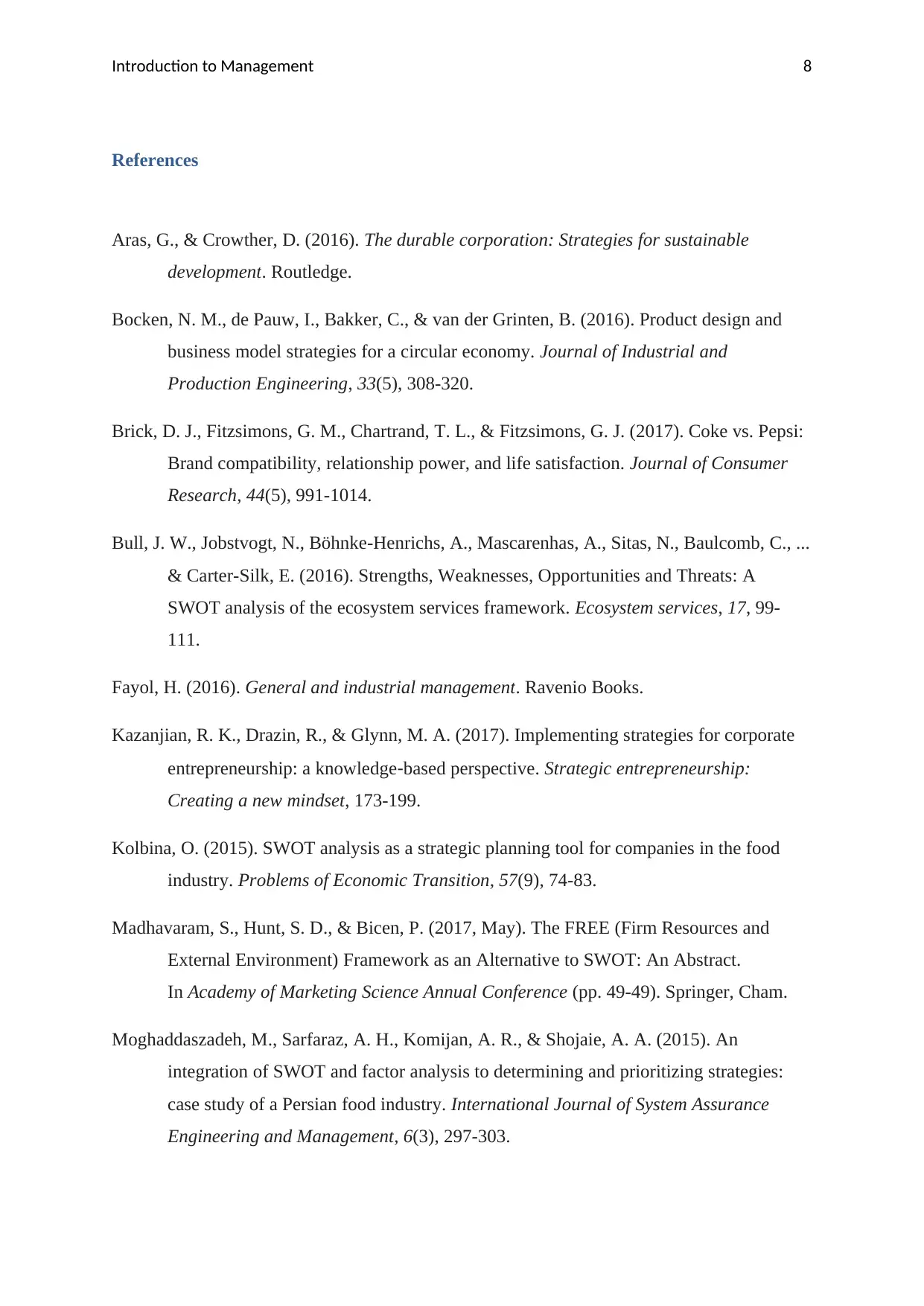
Introduction to Management 8
References
Aras, G., & Crowther, D. (2016). The durable corporation: Strategies for sustainable
development. Routledge.
Bocken, N. M., de Pauw, I., Bakker, C., & van der Grinten, B. (2016). Product design and
business model strategies for a circular economy. Journal of Industrial and
Production Engineering, 33(5), 308-320.
Brick, D. J., Fitzsimons, G. M., Chartrand, T. L., & Fitzsimons, G. J. (2017). Coke vs. Pepsi:
Brand compatibility, relationship power, and life satisfaction. Journal of Consumer
Research, 44(5), 991-1014.
Bull, J. W., Jobstvogt, N., Böhnke-Henrichs, A., Mascarenhas, A., Sitas, N., Baulcomb, C., ...
& Carter-Silk, E. (2016). Strengths, Weaknesses, Opportunities and Threats: A
SWOT analysis of the ecosystem services framework. Ecosystem services, 17, 99-
111.
Fayol, H. (2016). General and industrial management. Ravenio Books.
Kazanjian, R. K., Drazin, R., & Glynn, M. A. (2017). Implementing strategies for corporate
entrepreneurship: a knowledge‐based perspective. Strategic entrepreneurship:
Creating a new mindset, 173-199.
Kolbina, O. (2015). SWOT analysis as a strategic planning tool for companies in the food
industry. Problems of Economic Transition, 57(9), 74-83.
Madhavaram, S., Hunt, S. D., & Bicen, P. (2017, May). The FREE (Firm Resources and
External Environment) Framework as an Alternative to SWOT: An Abstract.
In Academy of Marketing Science Annual Conference (pp. 49-49). Springer, Cham.
Moghaddaszadeh, M., Sarfaraz, A. H., Komijan, A. R., & Shojaie, A. A. (2015). An
integration of SWOT and factor analysis to determining and prioritizing strategies:
case study of a Persian food industry. International Journal of System Assurance
Engineering and Management, 6(3), 297-303.
References
Aras, G., & Crowther, D. (2016). The durable corporation: Strategies for sustainable
development. Routledge.
Bocken, N. M., de Pauw, I., Bakker, C., & van der Grinten, B. (2016). Product design and
business model strategies for a circular economy. Journal of Industrial and
Production Engineering, 33(5), 308-320.
Brick, D. J., Fitzsimons, G. M., Chartrand, T. L., & Fitzsimons, G. J. (2017). Coke vs. Pepsi:
Brand compatibility, relationship power, and life satisfaction. Journal of Consumer
Research, 44(5), 991-1014.
Bull, J. W., Jobstvogt, N., Böhnke-Henrichs, A., Mascarenhas, A., Sitas, N., Baulcomb, C., ...
& Carter-Silk, E. (2016). Strengths, Weaknesses, Opportunities and Threats: A
SWOT analysis of the ecosystem services framework. Ecosystem services, 17, 99-
111.
Fayol, H. (2016). General and industrial management. Ravenio Books.
Kazanjian, R. K., Drazin, R., & Glynn, M. A. (2017). Implementing strategies for corporate
entrepreneurship: a knowledge‐based perspective. Strategic entrepreneurship:
Creating a new mindset, 173-199.
Kolbina, O. (2015). SWOT analysis as a strategic planning tool for companies in the food
industry. Problems of Economic Transition, 57(9), 74-83.
Madhavaram, S., Hunt, S. D., & Bicen, P. (2017, May). The FREE (Firm Resources and
External Environment) Framework as an Alternative to SWOT: An Abstract.
In Academy of Marketing Science Annual Conference (pp. 49-49). Springer, Cham.
Moghaddaszadeh, M., Sarfaraz, A. H., Komijan, A. R., & Shojaie, A. A. (2015). An
integration of SWOT and factor analysis to determining and prioritizing strategies:
case study of a Persian food industry. International Journal of System Assurance
Engineering and Management, 6(3), 297-303.
⊘ This is a preview!⊘
Do you want full access?
Subscribe today to unlock all pages.

Trusted by 1+ million students worldwide
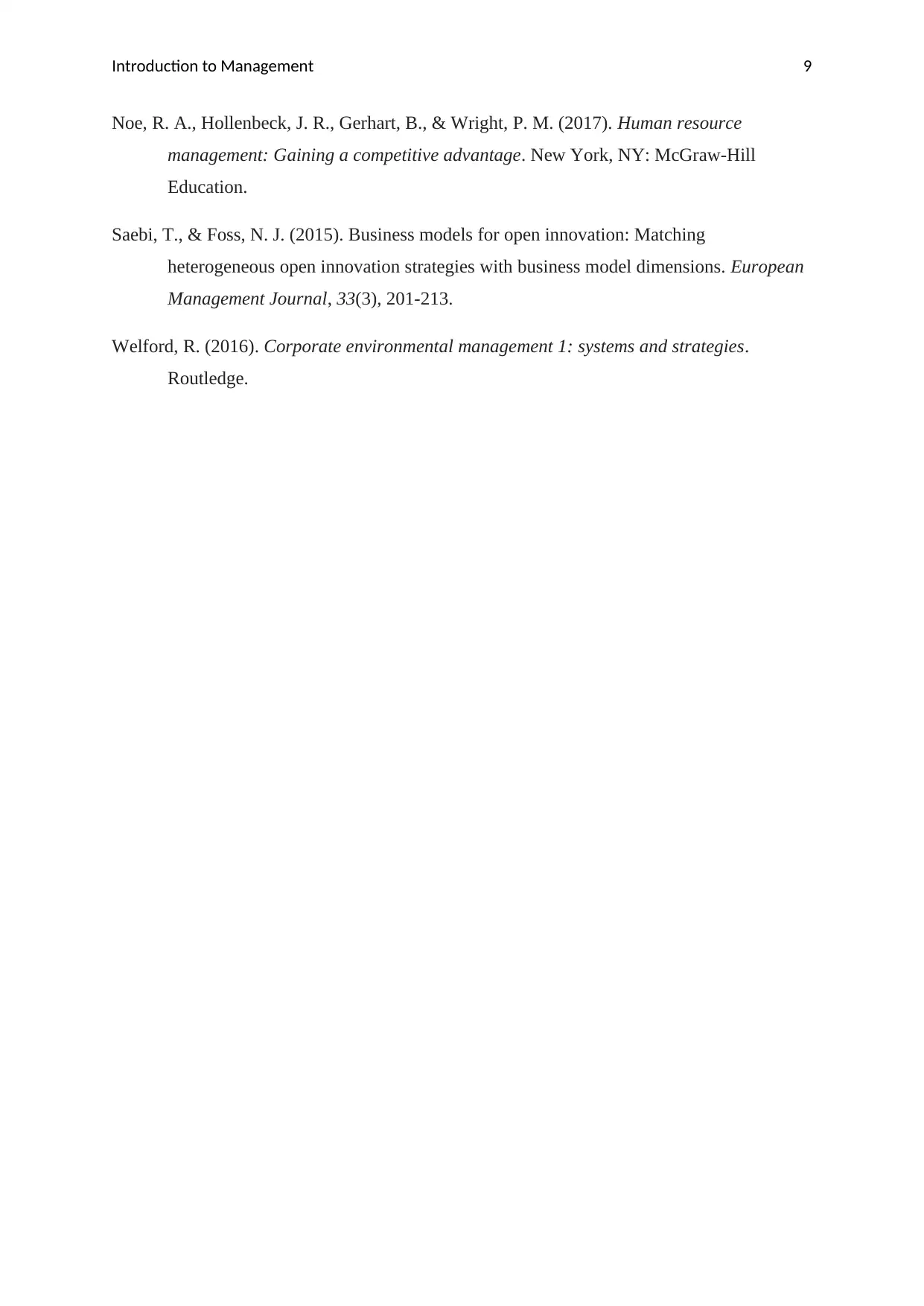
Introduction to Management 9
Noe, R. A., Hollenbeck, J. R., Gerhart, B., & Wright, P. M. (2017). Human resource
management: Gaining a competitive advantage. New York, NY: McGraw-Hill
Education.
Saebi, T., & Foss, N. J. (2015). Business models for open innovation: Matching
heterogeneous open innovation strategies with business model dimensions. European
Management Journal, 33(3), 201-213.
Welford, R. (2016). Corporate environmental management 1: systems and strategies.
Routledge.
Noe, R. A., Hollenbeck, J. R., Gerhart, B., & Wright, P. M. (2017). Human resource
management: Gaining a competitive advantage. New York, NY: McGraw-Hill
Education.
Saebi, T., & Foss, N. J. (2015). Business models for open innovation: Matching
heterogeneous open innovation strategies with business model dimensions. European
Management Journal, 33(3), 201-213.
Welford, R. (2016). Corporate environmental management 1: systems and strategies.
Routledge.
1 out of 10
Related Documents
Your All-in-One AI-Powered Toolkit for Academic Success.
+13062052269
info@desklib.com
Available 24*7 on WhatsApp / Email
![[object Object]](/_next/static/media/star-bottom.7253800d.svg)
Unlock your academic potential
Copyright © 2020–2025 A2Z Services. All Rights Reserved. Developed and managed by ZUCOL.





